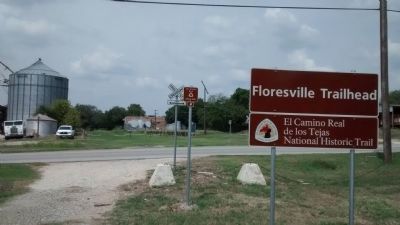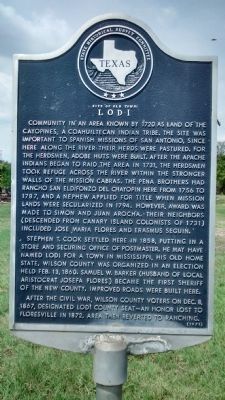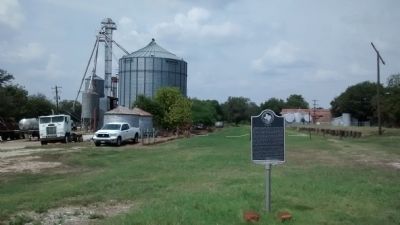Floresville in Wilson County, Texas — The American South (West South Central)
Site of Old Town: Lodi
Stephen T. Cook settled here in 1858, putting in a store and securing office of postmaster. He may have named Lodi for a town in Mississippi, his old home state. Wilson County was organized in an election held Feb. 13, 1860. Samuel W. Barker (husband of local aristocrat Josefa Flores) became the first sheriff of the new county. Improved roads were built here.
After the Civil War, Wilson County voters on Dec. 8, 1867, designated Lodi county seat — an honor lost to Floresville in 1872. Area then reverted to ranching.
Erected 1971 by State Historical Survey Committee. (Marker Number 4866.)
Topics and series. This historical marker is listed in these topic lists: Hispanic Americans • Native Americans • Settlements & Settlers. In addition, it is included in the El Camino Real de los Tejas National Historic Trail series list. A significant historical month for this entry is February 1848.
Location. 29° 8.113′ N, 98° 9.906′ W. Marker is in Floresville, Texas, in Wilson County. Marker is at the intersection of Trail Street (Farm to Market Road 536) and Goliad Road, on the right when traveling south on Trail Street. Touch for map. Marker is in this post office area: Floresville TX 78114, United States of America. Touch for directions.
Other nearby markers. At least 8 other markers are within walking distance of this marker. White House Café and Saloon (approx. 0.4 miles away); First Baptist Church of Floresville (approx. 0.4 miles away); Floresville United Methodist Church (approx. 0.4 miles away); Captain Will Wright (approx. half a mile away); The Flores de Abrego Family and Floresville (approx. half a mile away); Wilson County Jail (approx. half a mile away); Wilson County (approx. half a mile away); Wilson County Courthouse (approx. half a mile away). Touch for a list and map of all markers in Floresville.

Photographed By Richard Denney, September 22, 2014
3. El Camino Real de los Tejas National Historic Trail
As noted on the marker, this site was important to Spanish missions of San Antonio and lay on the Camino Real to and from San Antonio, and is now a recognized stop as part of the El Camino Real de los Tejas National Historic Trail.
Lodi marker is visible in distance, across the street.
Credits. This page was last revised on October 20, 2016. It was originally submitted on September 24, 2014, by Richard Denney of Austin, Texas. This page has been viewed 789 times since then and 33 times this year. Photos: 1, 2, 3. submitted on September 24, 2014, by Richard Denney of Austin, Texas. • Bernard Fisher was the editor who published this page.

